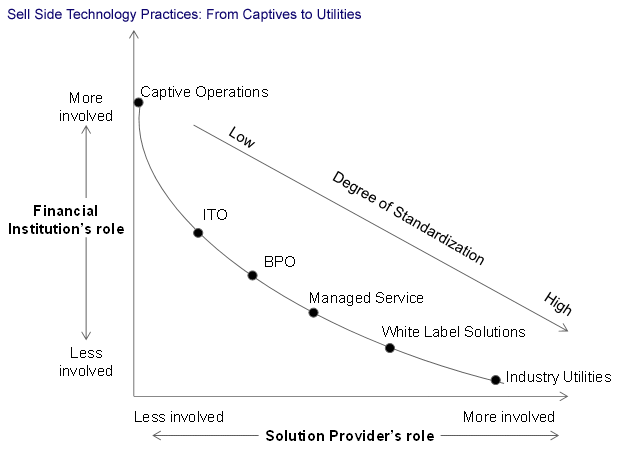The Evolution of Sell Side Equities Technology Practices
From Captives to Utilities
Abstract
Ever-present competition, stringent regulations, and weak trading volumes are leading to poor economics for sell side firms in equities trading. Since these firms have already taken measures to reduce capacity in the short run, it is now time to undertake a radical review of their IT strategy.
In the report The Evolution of Sell Side Equities Technology Practices: From Captives to Utilities, Celent identifies and discusses emerging technology practices to enable cost reduction in equities trading for sell side firms in the long run. The US economy has been on a path of slow but steady recovery since 2009–2010, but equity trading volume is still significantly down compared to the levels seen in 2007–2008 due to persistently low volatility. With a radical departure from this trend unlikely in the near future, sell side firms should address overall technology strategies with a longer-term view.
Celent believes sell side firms should focus on their core business by looking to reduce in-house involvement for nondifferentiating activities through outsourcing to external providers.
Outsourcing is not new to the industry, but its adoption has been expedited in recent years due to changing market conditions. Sell side institutions that previously outsourced smaller pieces of technology are increasingly looking to engage with external providers under a “managed service” model, where the provider is responsible for building and maintaining different aspects of operations on an ongoing basis. This is emerging as a popular model, especially among small and midsize sell side players.
In the last 6 to 12 months, we have seen the emergence of the utility model, a highly standardized offering built by a third party provider and offered on a pay-per-use basis to a broader segment of the industry.

“The utility model is still in its early days and is seen in modular offerings in areas such as KYC registry and collateral management,” says Arin Ray, an analyst with Celent’s Securities & Investments practice and author of the report. “This model, through achieving industrywide common standard and economies of scale, has the potential to reduce costs for the industry as a whole and therefore promises to be a significant step forward in the evolution of sell side technology practices.”
This report adds to Celent’s ongoing discussion on innovation in cash equities trading operations and begins with analyzing the evolution of equities trading volume. In doing so Celent identifies the factors driving change in the equity market. The report discusses the measures sell side firms have taken in the short term in response to the crisis of 2008, followed by ideas and examples of emerging strategies for cost reduction in the long run.

